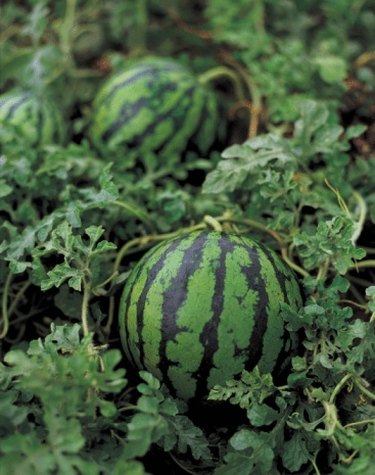
Watermelon is grown in both residential and commercial gardens. Watermelons are available in both seeded and seedless varieties and range in size based upon the variety grown. Watermelon is eaten fresh and used in many culinary dishes for its nutritional value. Watermelon is a source of lycopene, which has proven effective in promoting cardiovascular health and preventing some types of cancer. Unfortunately, it is sometimes damaged by a variety of pests that feed on the plant, the fruit or both.
Cucumber Beetles
Video of the Day
Both banded cucumber beetles and striped cucumber beetles are pests of watermelon plants. If the watermelons are planted near other crops such as cucumbers, squash and cantaloupe, they can damage those crops as well. This pest feeds on both the stems and leaves produced by the watermelon plant. In just a single year, many generations of beetles can feed on a single plant. The younger the plant is when it is attacked, the more severe the damage to fruit yield.
Video of the Day
Rindworms
The rinds of the watermelon fruit are very appealing to various types of worms. As a whole, these are referred to as rind worms. Some common rind worms include armyworms, tobacco budworms, earworms and salt-marsh caterpillars. The damage caused by these pest can range from feeding on foliage and stems to eating the rind itself, thus making the fruit unsuitable for sale or consumption.
Whiteflies
Dozens of varieties of whiteflies feed on watermelon plants. These flying pests feed on the sap produced by the plant, resulting in fewer nutrients for the plant itself. In addition to causing direct damage, whiteflies also transmit viruses to the watermelon plant, such as squash leaf curl and lettuce infectious yellows. If whiteflies are present on the plant, they are typically located on the underside of leaves.
Seedcorn Maggots
Seed-corn maggots are capable of causing significant damage while the plant is young, still in the seedling stage. The adults lay their eggs in overly fertile soils or manure and frequently infest whole crops. As maggots hatch, they begin to feed on the stems and seed of the plant. In mild cases, the plant experiences reduced vigor, while more severe cases completely kill the plant.
Cutworms
Cutworms are a second pest that attacks watermelon plants while they are just seedlings. These worms are caterpillars that appear greasy. Cutworms attack the stems first, cutting into them and reducing the health and strength of the seedling. As they continue to feed they work their way up to the foliage, chewing large holes in the foliage. These pests can be found feeding from the spring through the fall.
Leafminers
Adult leafminers are flies that feed on the leaves produced by the watermelon plant. These flies then lay egg around the holes in the foliage they created. The maggots that result continue to feed on the leaves, causing more extensive damage. In mild cases, foliage damage is the only concern. In more severe cases, defoliation occurs which results in fruit that is not protected from the sunlight and which becomes scalded as a result.
Animal Pests
There are many wild animals that also feed on the watermelon fruit. If these animals have access to a watermelon crop, they can cause significant damage to the fruit, reducing the yield. Among the most prevalent of the animal pests are coyotes, deer, raccoons and crows. This damage typically occurs once the watermelon is ripe, so prompt harvest is an essential step of prevention.